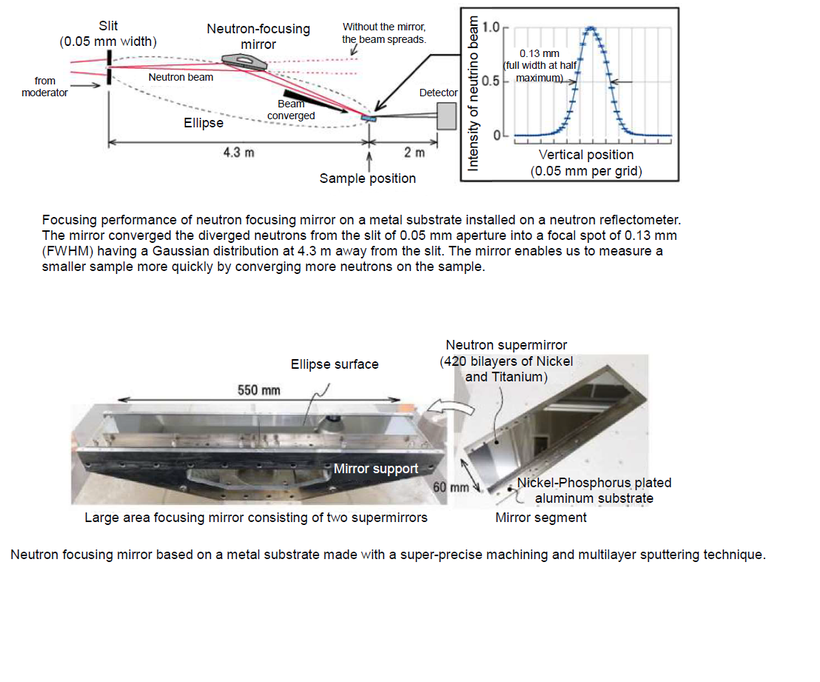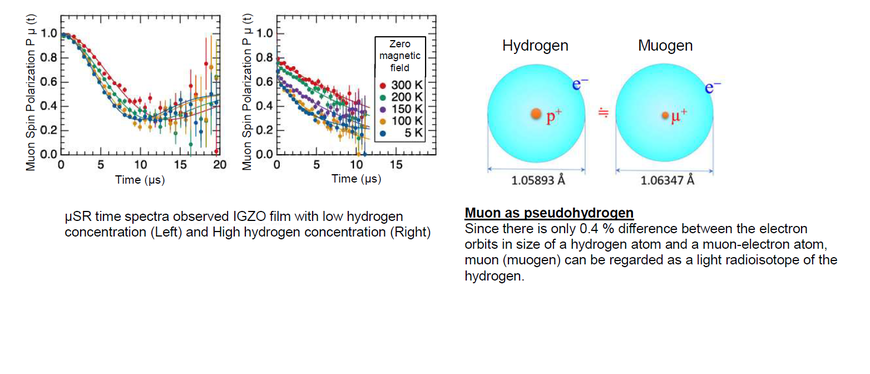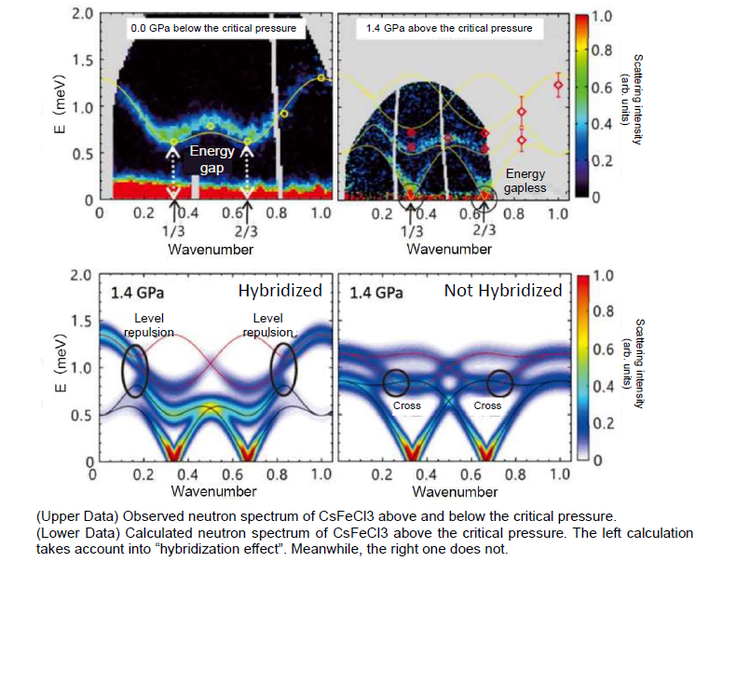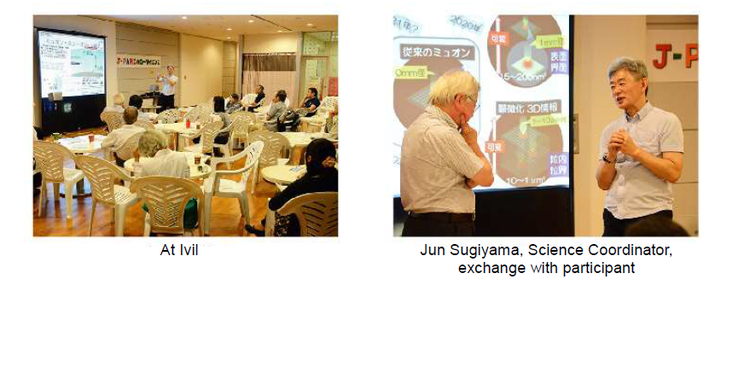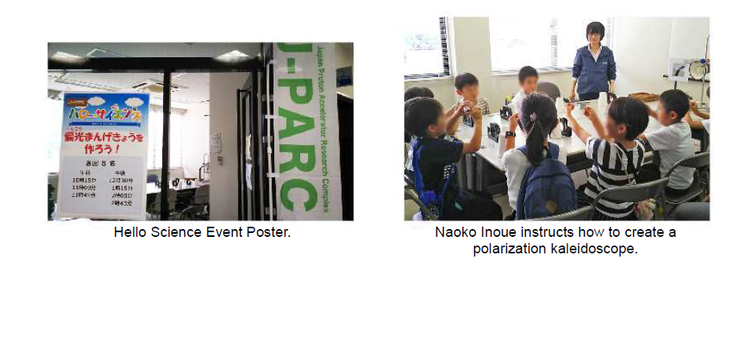J-PARC NEWS October 2019 (Issue #174)
■ Ultrahigh Precision Metallic Neutron Focusing Mirror - High anticipation for increased use of broad range of neutron beam focusing devices (September 19, press release)
In the Materials and Life Science Experimental Facility (MLF) at J-PARC, various experiments for studying the way atoms and molecules are arranged and move in functional materials with the world’s most intense neutron beam. Yet the neutron beam naturally diverges as it travels from its source to the sample position, meaning only a small ratio of the original beam reaches the sample. The “neutron focusing mirror” is a device that converges the widened beam onto a single point. Neutrons that otherwise would have been wasted as they missed the target sample can be converged on a sample, which helps reduce the measurement time significantly. Such a “neutron focusing mirror” consists of a metallic multilayer film called a “neutron super mirror” onto a curved substrate with a smoothness on the level of 0.1 nm (one ten billionth of a meter) and an outstanding profile accuracy with a waviness tolerance of just 0.001º (equivalent of a gradient tens of mm over a 1 km span). With conventional technology, substrates like these could only be made using optical glass, silicon or other hard-to-machine materials, and making these into large sizes and/or complex shapes was difficult. To develop the focusing mirror, the research group turned its attention to amorphous electroless nickel phosphorus plating, which is used for lens molds as it is easy to machine and make a required smooth surface. The group developed a method for making neutron focusing mirrors of a broad range of shapes, by depositing an electroless nickel phosphorus plating onto aluminum alloy machined into the approximate shape, polishing it and then forming a neutron super mirror multilayer film on top. The metallic substrate is easy to assemble and connect, meaning multiple focusing mirrors can be connected to form a larger mirror. The developed focusing mirror was installed on the SOFIA reflectometer in MLF, and beams were observed to be focused to a point just over 0.1 mm with outstanding accuracy on the sample position located 4.3 m away from the virtual source, which is the highest level of focusing performance in the world. The developed manufacturing method can be applied to sophisticated neutron beam focusing mirrors with more complex, three-dimension shapes, which helps material researches by acquiring higher quality data with more advanced neutron optics.
■ Minute Hydrogen Behavior Affecting Display Semiconductor Performance Revealed – Muon Elementary Particles Explain Localized Electronic State of Hydrogen Impurities in IGZO Transparent Semiconductors (September 27, press release)
The oxide semiconductor InGaZnO4 (IGZO) that has soared in popularity in recent years as a material used in displays, suffers from performance issues caused by hydrogen impurities. This research implants a positive muon* (μ+) (*simply referred to as muon below) into IGZO samples under a range of conditions, and the state of muons as pseudo hydrogen is studied by the μSR (muon spin rotation/relaxation) experiment. Measurements were taken by J-PARC’s muon instrument S1-ARTEMIS and another muon instrument at the Paul Scherrer Institute in Switzerland.
For IGZO films with a low hydrogen concentration, μSR time spectra observes linewidth of local magnetic field at the muon site. The magnitude of the linewidth combined with our calculation suggests that muon (Mu+) without an electron occupied Zn-O bond-center site. The muon acting as pseudo hydrogen implies that actual hydrogen becomes ionized (H → H++e-) to supply an electron, which unintentionally causes an n-type conductivity. Meanwhile, increasing the hydrogen concentration of IGZO films exhibits an exponential curve that differs to a low hydrogen concentration, indicating the configuration of atoms around the muon is in disorder, as well as the fact that muons are present next to hydrogen atoms. This backs up the recent theoretical predictions that two hydrogen atoms are captured in an oxygen vacancy to create a negative ion state called 2H-. This suggests that a muon acting as a pseudo hydrogen is captured in an oxygen vacancy where a single hydrogen is already present. The 2H- fills the vacancy after the O2- ion is gone, in this case, there is no electron released. Yet light excitation is known to induce such negative hydrogen ions to supply electrons to the conduction band, which may cause performance issues.
These results indicate that observing the state of muons as pseudo hydrogens is effective for acquiring microscopic information on ultra-small quantities of hydrogen impurities that impact performance of electronic materials like semiconductors and dielectric substances, and it is hoped that this research will be applied to a broad range of electronic materials in the future.
For further details, please click the following link. https://aip.scitation.org/doi/full/10.1063/1.5117771
■ Discovery of Hybridized Excitations in Frustrated Quantum Magnets - Mutual excitation give way to each other (October 19, press release)
It is reported that, in frustrated quantum magnet CsFeCl3, pressure induces quantum phase transition from a “quantum disorder state” to a “noncollinear magnetically ordered state” where the magnetic state is such that adjacent spins (micro magnets) are not either parallel or antiparallel. This is an ideal model material for experimental verification of excitation modes blending “phase fluctuations” and “amplitude fluctuations.” This research used J-PARC’s High Resolution Chopper Spectrometer HRC and the spectrometer at Oak Ridge National Laboratory to conduct neutron scattering experiments to determine the dynamic state of spin of the material under a range of different pressures.
The result shows spectrums with minimum energy gaps at wave numbers 1/3 and 2/3 in a quantum disorder state at less than the critical pressure as shown in the image below. The gradient at 1/3 and 2/3 is 0, which suggests that the spin thermal conductivity and spin wave velocity are being significantly limited. Conversely, the energy gaps at wave numbers 1/3 and 2/3 are closed in the noncollinear magnetically ordered state at more than the critical pressure. The spectrum has a gradient that is not zero, which suggests that the spin thermal conductivity and spin current are becoming larger.
Characteristic spectra are also observed in the 0.5-0.8 meV and 0.8-1.3 meV ranges. In theoretical calculations, when the characteristics of noncollinear order is properly accounted for, the phase mode and amplitude mode are occurred together (hybridization), and level repulsions are shown between the two modes, which is consistent with the experiments. (The level repulsions between the two spectrum curves at low energy side and two spectrum curves on the high energy side.) When intentionally calculated ignoring the hybridization effect, the two modes cross without giving way to one another, which cannot reproduce. This research will determine the course related to studies of the dynamic state of materials under various pressures using neutron scattering experiments, and it is anticipated that these experiments may lead to applications as thermal flow or spin current switching devices.
For further details, please see the following link. https://advances.sciencemag.org/content/5/10/eaaw5639
■ 33rd J-PARC Hello Science “Identifying Energy Related Materials with Muon Particles” (September 20,Tokai-mura Industry and Information Plaza “iVil”)
The Materials and Life Science Experimental Facility covers a broad range of research, from the basics to industrial applications using neutrons and muon particles (hereinafter, muons). Hello Science in September featured a talk on research into energy-related materials using muons, by inviting Jun Sugiyama, a science coordinator who worked at Toyota Central R&D Labs until March this year before being assigned to the Neutron Science and Technology Center of the Comprehensive Research Organization for Science and Society (CROSS) in April. His lecture focused on the properties of muons that can be used to study the subtle movement of particles within materials, as well as case studies like observing active volcanos by using cosmic ray muons hitting the ground to take transfer imaging of volcanos. Other topics included the principle of observing the insides of materials using the μSR method with muons generated by accelerators, and the current state of R&D on energy storage materials like lithium ion batteries. The lecture was moderated by Naoko Inoue of the Public Relations Section, who allowed time to address questions raised by members of the audience.
■ J-PARC Hello Science at Nuclear Fusion Facilities Tour “Let’s Make a Polarizing Kaleidoscope!” (October 20, Naka City, Naka Fusion Institute)
A tour of facilities was held on October 20 at the National Institutes for Quantum and Radiological Science and Technology Naka Fusion Institute in Naka city, where the J-PARC Center ran a Hello Science “Let’s Make a Polarizing Kaleidoscope!” hands-on workshop. Seven workshops a day were led by Naoko Inoue of the Public Relations Section and the Science Communicator Shinichi Sakamoto, with a total of 59 participants ranging from preschoolers to adults taking part. Models used in the workshop explained that light was a form of waves. Then participants made kaleidoscopes using polarized sheet, transparent sheet and paper cups. Participants were amazed at the beautiful shapes and colors created by rotating the two paper cups, with some shouting out “Wow!” in excitement.

